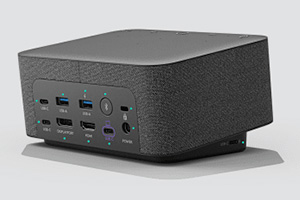2 min read
Hybrid work is the future – is your organization prepared?
As we move forward in 2022, there appears to be a glimmer of optimism that we could possibly be moving on from this global pandemic. It’s a promising...
-3.png)
The COVID-19 pandemic forced businesses to quickly adapt to remote and hybrid work models to maintain their operations. A traditional office transformation ensued. Microsoft took notice.
The tech giant designed Windows 11 to embolden a hybrid workforce. Developers focused on providing simpler ways for users to interact, stay connected, and be more productive. As a result, Windows 11 is helping reshape the hybrid work culture. And that’s welcome news for the 74% of U.S. companies that are using or plan to implement a permanent hybrid work model.1
This article will explore how Windows 11:
Powering Productivity and Collaboration
More work is happening remotely than ever before. And while 80% of employees say they are just as or more productive since going remote or hybrid, employers aren’t so sure. Less than half of leaders share their employees’ optimism.2
Windows 11 aims to give employers greater peace of mind with a variety of features that improve productivity and collaboration.
A snappier Windows 11 user interface
Microsoft Teams integration within Windows 11 makes collaboration more accessible
And using Teams integrated with Windows 11 Pro for business offers several confidence-building features.
Improved touch and pen support
Windows 11 makes life easier for users who want to take notes, draw, and annotate documents with the touch of a finger or pen. This boost in OS support helps improve collaboration and increase productivity.
Enhancing Hybrid Security
One of the biggest concerns with hybrid work is security. The shift to remote work has been a welcome change for cybercriminals who want to exploit remote system vulnerabilities. Windows 11 offers next-level security to counter these threats.
Zero-Trust security model
“Zero Trust” means no user or device anywhere can have access until safety and integrity are proven. It’s an evolution in cybersecurity that’s based on three principles:
Hardware-based security
Windows 11 advances security even further with built-in protections.
Encryption and data protection
Wherever people travel with their devices, so goes their confidential information. That data must be protected against unauthorized access. Whether it happens through device theft or malicious applications, it poses significant risks. Windows 11 features three safeguards for this sensitive information.
Malware protection
Malware attackers frequently exploit driver vulnerabilities and even the system's security solutions to compromise them. Windows 11 includes, by default, these malware protection measures:
Secure sign-in and a controlled sandbox
There are two additional security features in Windows 11 that we’re excited to see.
Windows Hello
This enhanced security feature allows users to sign in to their Windows 11 devices using a PIN or biometric authentication in the form of a fingerprint or facial recognition. Windows Hello improves security by reducing end users’ reliance on passwords that are easier for cybercriminals to hack.
Windows Sandbox
Developers are undoubtedly familiar with working in a sandbox environment. It’s a controlled and isolated environment where they can safely test their code, applications, or software without affecting network resources, user data, or local applications.
Windows Sandbox serves the same purpose: creating a secure environment where users can safely run potentially harmful applications or files. Note, however, that Windows Sandbox is not included in the Windows 11 Home edition as of this writing.
Simplifying Hybrid Deployment and Management
Deploying and managing devices in a hybrid work environment can be complex, adding pressure to IT departments already spread too thin.
Windows 11 introduces several features to make life easier for IT professionals
Work with your existing apps and infrastructure
Take a flexible path to cloud management with Microsoft Endpoint Manager
Move to Universal Print via the cloud
Deploy devices with cloud configuration for endpoint management
Three additional features also got our attention:
Windows Autopilot
Improved update management capabilities
Azure Virtual Desktop
In conclusion, Windows 11 has positioned itself as a leading operating system for hybrid work. Its features make it easier for businesses to adapt to the new way of working. As more companies adopt hybrid work models, Windows 11's features will continue to be essential for enhancing productivity, improving security, and simplifying deployment and management.
With Windows 11, the hybrid work culture has been reshaped for the better. Businesses can confidently march forward in this new era of work.
Sources:

2 min read
As we move forward in 2022, there appears to be a glimmer of optimism that we could possibly be moving on from this global pandemic. It’s a promising...

1 min read
For IT leaders who make it a point of emphasis to drive workplace modernization, these last few years have been challenging, to say the least. The...

2 min read
Over the last few years, we’ve witnessed a dramatic shift in the way companies approach workplace modernization – and for obvious reasons. It’s still...